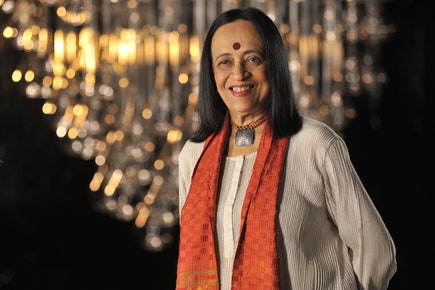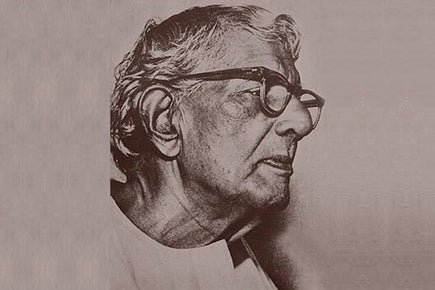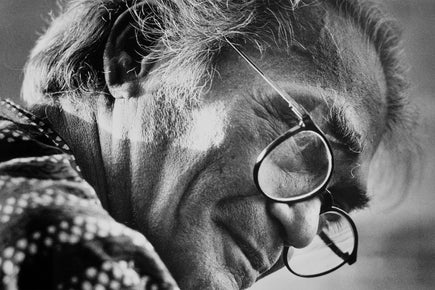Jehangir Sabavala: A Master’s Lasting Impression on Indian Modern Art
Known by his Dali-esque moustache, well-tailored suit, a silk cravat neatly tucked into the collar and polished shoes, 20th century artist Jehangir Sabavala left an indelible mark on Indian art, in his eternal quest to find lyricism and serenity in the world. Though lesser known than his contemporaries such as Akbar Padamsee, Tyeb Mehta, M.F. Husain or S.H. Raza, Sabavala is still celebrated for his significant contribution to Indian modern art.
 Mirror Image by Jehangir Sabavala - Click to Purchase this Limited Edition Serigraph on Artisera
Mirror Image by Jehangir Sabavala - Click to Purchase this Limited Edition Serigraph on Artisera
An Enviable Education and Illustrious Career
Born in 1922, Jehangir Sabavala hailed from an affluent Parsi aristocratic family in Mumbai and was trained at some of the best art colleges in the world, including the Sir J.J. School of Art in Mumbai, the Heatherley School of Art in London, and the Academie Andre Lhote, the Academie Julian, and the Academic de la Grande Chaumiere in Paris.
 Jehangir Sabavala
Jehangir Sabavala
Sabavala started his career with a solo show in a hotel room at the Taj Mahal Hotel in Mumbai, which M.F. Husain assisted in putting up. Even though he was around at the time when the Progressive Artists’ Group was created (a movement consisting of artists who moved away from the restrained style of the Bengal School and gave Indian art a new, free-wheeling artistic identity post-Independence), Sabavala didn’t find a place in it, because he was bound by the academic traditions of European art. Being termed ‘academic’, however, didn’t ruffle him in any way, as it was just one aspect of his large body of work.
 Under Sail by Jehangir Sabavala - Click to Purchase this Limited Edition Serigraph on Artisera
Under Sail by Jehangir Sabavala - Click to Purchase this Limited Edition Serigraph on Artisera
In a career that spanned more than sixty years, Sabavala took part in over thirty solo shows in India and internationally. He was honoured with the Padma Shri by the Government of India in 1977, and the Lalit Kala Ratna by the President of India in 2007.
His artwork titled The Casuarina Line – I fetched Rs. 1.7 crores, three and a half times more than the pre-sale estimate of Rs. 50 lakhs, in a 2010 SaffronArt auction. In 2016, another artwork titled Stag-Antlered Trees got sold for Rs. 2.16 crores at a SaffronArt auction.
 The Casuarina Line - I (2002) by Jehangir Sabavala
The Casuarina Line - I (2002) by Jehangir Sabavala
An Evolving Style
As part of his study in Europe, Sabavala let the viewer witness his process of constructing the human form, as he made several charcoal and pencil sketches on paper between the years 1946 and 1948. Following that, due to his training from 1947 to 1951 with Andre Lhote, a French Cubist painter, he imbibed the Cubist precepts of constructing objects not as they appeared to the eye, but in relation to other entities. Sabavala resisted being tied down to one philosophy or one style of art. His style was a blend of Cubism and Impressionism, that adapted to the challenges of India and adjusted to its vibrant colours and landscapes.
 The Bangle Sellers (1954) by Jehangir Sabavala
The Bangle Sellers (1954) by Jehangir Sabavala
By the mid-1960s, not wanting to be confined by an uninspired style of painting, Sabavala began to reinvent himself as an artist. Prominent, bold, sharp lines started transforming into softer, intangible structures. As he played with light and shadow, his use of colours changed from vibrant to sombre. This transformation is apparent in his body of work, as he moved from bright Indian settings, to seascapes and even cityscapes in his later years.
 Of Cliff and Fall III (1978) by Jehangir Sabavala
Of Cliff and Fall III (1978) by Jehangir Sabavala
Of Influences, Inspirations and Intellect
Jehangir Sabavala was perpetually seeking inspiration, and his art is a testament to that. The subjects in his paintings vary from nature to poetry to abstract figures, and all of them flow organically into his canvas. The artist led a peripatetic life - he would often trek along the Western Ghats with his brother to absorb nature in its full sense and reproduce its scenic views in his distinctive style. He also frequently painted scenes from Gholvad, a village in Maharashtra which he would frequently visit with his friend. Influenced by ancient Asian culture, especially that of Japan, Sabavala would depict cranes in a beautiful backdrop, as they represent good fortune and longevity.
 Flight III by Jehangir Sabavala
Flight III by Jehangir Sabavala
Often philosophical in his approach, and inspired by the culture prevalent in the Himalayas, he would frequently feature figures clad in either black or white robes against a landscape that could either be a variant of the Western Ghats or the Alps. The mysterious figures, with a mystical aura were, according to him, wayfarers who could be anyone, ranging from an ascetic to a monk to anyone in the world set on the journey of life.
 In The World's After Light by Jehangir Sabavala - Click to Purchase this Limited Edition Serigraph on Artisera
In The World's After Light by Jehangir Sabavala - Click to Purchase this Limited Edition Serigraph on Artisera
A thorough intellectual, Sabavala pondered about social issues, which reflects in his paintings. For instance, ‘The Purdah Series’ is an agonised view of the enslavement and bondage of women. Best described as sad and angsty, his paintings regularly featured subjects in turbulence or turmoil. One such painting that imparts this anguish is ‘The Flight into Egypt’, which is an episode of the Biblical event that follows Mary and Joseph, who, after learning from the Magi about King Herod’s ploy to kill all infants in Bethlehem, fled on a donkey with infant Jesus to Egypt.
 Purdah - I by Jehangir Sabavala - Click to Purchase this Limited Edition Serigraph on Artisera
Purdah - I by Jehangir Sabavala - Click to Purchase this Limited Edition Serigraph on Artisera
A Legacy Beyond Art
Jehangir Sabavala has created art from poetry and has inspired poets to create poetry from his art. He created pictorial representations of poems like Samuel Taylor Coleridge’s Kubla Khan and Gertrude Stein’s Sacred Emily, in his own cubist idiom. His paintings have inspired poets like Ranjit Hoskote, Jerry Pinto, and Arundhathi Subramaniam.
 Down To A Sunless Sea (1962) - A representation of
Down To A Sunless Sea (1962) - A representation of
Samuel Coleridge's poem, Kubla Khan
Among other contributions to the literary world, are three monographs that have been published on Sabavala’s oeuvre by eminent art publishers such as the house of Tata-McGraw-Hill and Lalit Kala Akademi. Noted filmmaker Arun Khopkar created a film based on his life titled ‘Colours of Absence’, which won the National Award in 1994. The phrase ‘Colours of Absence’ was coined by the late writer and poet, Dom Moraes, for Sabavala’s work.
 (From left to right) Piyush Shah, Arun Khopkar, and Jehangir Sabavala
(From left to right) Piyush Shah, Arun Khopkar, and Jehangir Sabavala
Jehangir Sabavala reinvented the artistic language of India through his contribution to Indian art. Even in his late 80s, he painted every day until he breathed last on 2nd September, 2011, leaving behind an irreplaceable void.

























































































